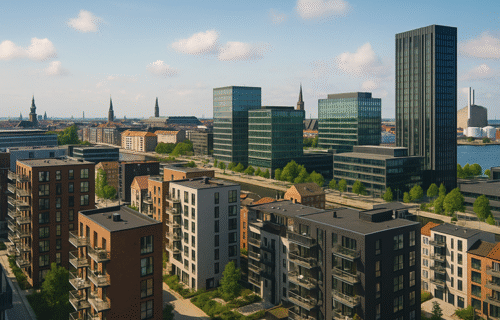Denmark’s property market maintained a steady course through the third quarter of 2025, with total transaction volume reaching approximately €9.4 billion in the first nine months of the year — nearly 50 percent higher than the same period in 2024. Despite a seasonal slowdown during the summer, investor activity remained resilient across all major sectors, supported by improving financing conditions and renewed international interest.
Greater Copenhagen accounted for close to 40 percent of total investment, underscoring its position as the country’s main focus for both domestic and foreign capital. International investors were particularly active, representing around one-third of total deal volume during the quarter. The living sector led activity with more than half of all transactions, followed by industrial and logistics assets at roughly one-fifth.
Key deals included Thylander Group and Goldman Sachs acquiring a majority stake in Bostad A/S, DWS’s purchase of a 215-unit residential complex in Brøndby, and Northern Horizon’s acquisition of a senior housing portfolio from AP Pension. Across the market, yields remained broadly stable, with slight compression in the logistics segment where pricing now averages around 5.0 percent.
The logistics sector continued to perform strongly, supported by steady occupier demand and disciplined development activity. Leasing volumes remained robust, driven by e-commerce, manufacturing, and third-party logistics operators seeking energy-efficient facilities. Development has been concentrated around the Copenhagen region and key corridors in Jutland, while speculative construction remains limited. Vacancy rates have stabilised, and prime yields compressed marginally as investor confidence improved.
The office market showed continued stability in the third quarter, with leasing activity largely centred on high-quality, sustainable buildings in prime locations. Demand from occupiers focused on upgrading to modern, energy-efficient offices, while secondary assets faced slower absorption. Rents in central Copenhagen edged higher, supported by constrained new supply and consistent demand. Investors have maintained a selective approach, prioritising assets with strong ESG credentials and long-term lease security.
Meanwhile, the multifamily sector continues to attract institutional capital as one of Denmark’s most resilient asset classes. Rental levels in Copenhagen have risen by around 18 percent since 2022, reflecting tight supply and strong population growth in the capital. High construction costs and financing constraints have limited new housing completions, further supporting rent increases. Regional markets also report stable rental growth, with emphasis on professionally managed, energy-efficient housing.
Across all sectors, the Danish property market is showing increasing signs of balance. Investment activity is underpinned by solid fundamentals, with pricing stability and strong occupier demand driving cautious optimism. Analysts expect continued momentum into 2026, supported by low interest rates, steady rental performance, and growing international participation.
